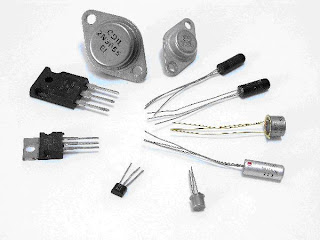An
electronic component forms a basic electronic element, which is
available in a discrete form that has two or more electrical terminals.
Electronic circuits are composed of many electronic components with
different characteristics. These components are necessary for the
circuit to perform the required function or purpose. The
terminals of the electronic elements or components are connected
together in a circuit board to create an electronic circuit that gives a
definite function. An electronic component or device can be classified into passive or an active component.
Electronic Components
Photo credit: made-in-china.com
Active Device
Active Device
An
active component device is one, which can supply energy into a circuit.
It can strengthen a signal applied to it and shows gain such a current or voltage gain. These components are capable of controlling the current or flow of electrons in
the device by means of another electrical signal applied to it. The
energy is derived from the current or electrons flowing through the
device by the application of another electrical signal. These components
need power to improve the signal level and the source of power is
usually obtained from the DC supply connected to the circuit. They also exhibit directional characteristics in the signal. These components can amplify the signal or increase power of the output electrical signal. Active components include components such as triode vacuum tubes, transistors, tunnel diodes, etc.
Thermionic Valves
Photo credit: 123rf.com
Transistors
Photo credit: mgitecetech.wordpress.com
Integrated Circuits
Photo credit: indiamart.com
Active
devices can be either current controlled or voltage controlled. When
another voltage is used to control the the current flow through the
device, it is called as voltage controlled, and if it is controlled by
another current, it is called as current controlled device.
Passive Device
A passive component or device, is one which cannot control the flow of current in the device.
It cannot rely on an outside electrical source. It cannot supply energy
into the connected circuit. They do not have gain and is not able
to amplify a signal that is introduced to it. It allows a signal to pass
through it and may often alter the impedance of the
out coming signal. Sometimes it can be lossy and there is a net loss of signal power in a passive device. It may attenuate a signal, voltage, or current when it passes through them. Passive devices
do not exhibit directional qualities to the signal. Depending on the
device they can sometimes increase the current or voltage of the signal
as seen in a transformer or a resonant circuit. Passive components
include resistors, capacitors, diodes, inductors, transformers, cables
etc.
Passive Components
Photo credit: tuttech.de
Passive components are further divided into lossless and lossy components.
Lossless components do not have a net power flow through it, either
into or out of it. Lossless components include capacitors, inductors,
transformers etc. Lossy components will absorb the power when it passes
through it. It dissipates power from the circuit and attenuates the
signal. Lossy components include resistors. Most non ideal passive
components are lossy in nature as it absorbs energy.





No comments:
Post a Comment